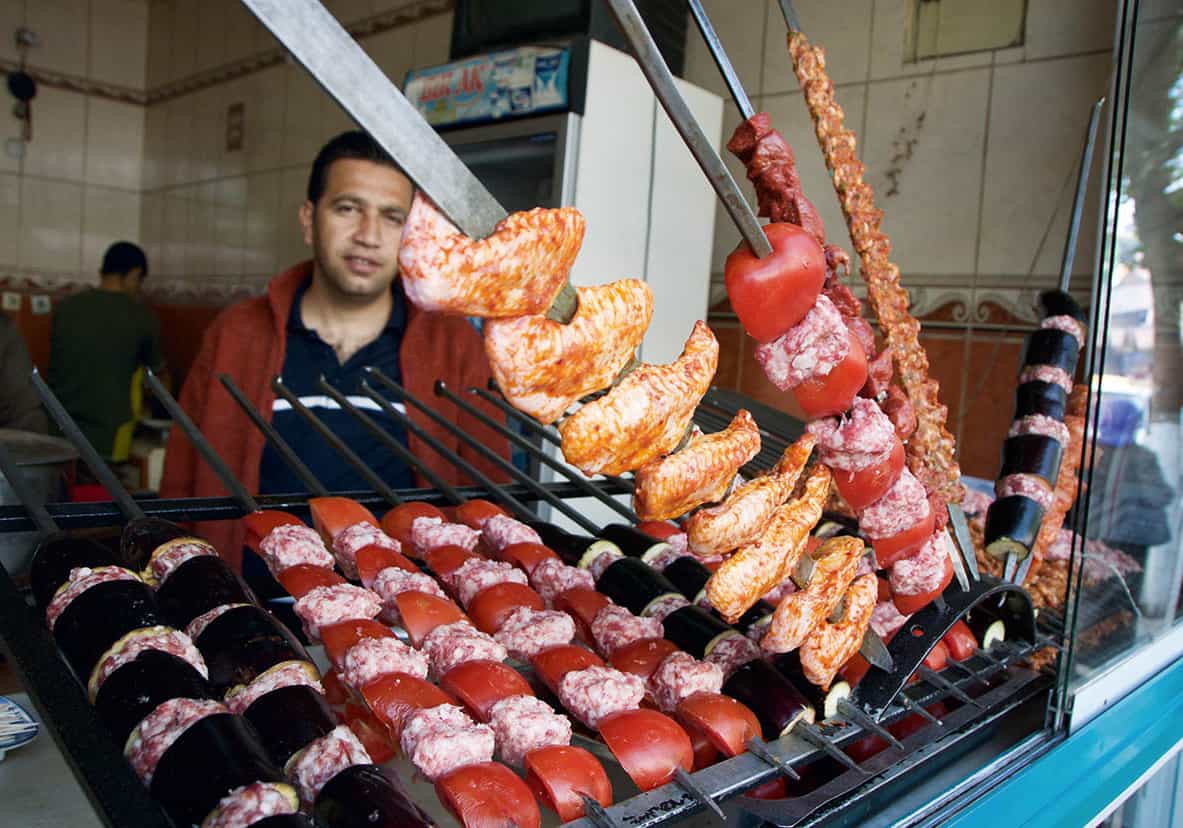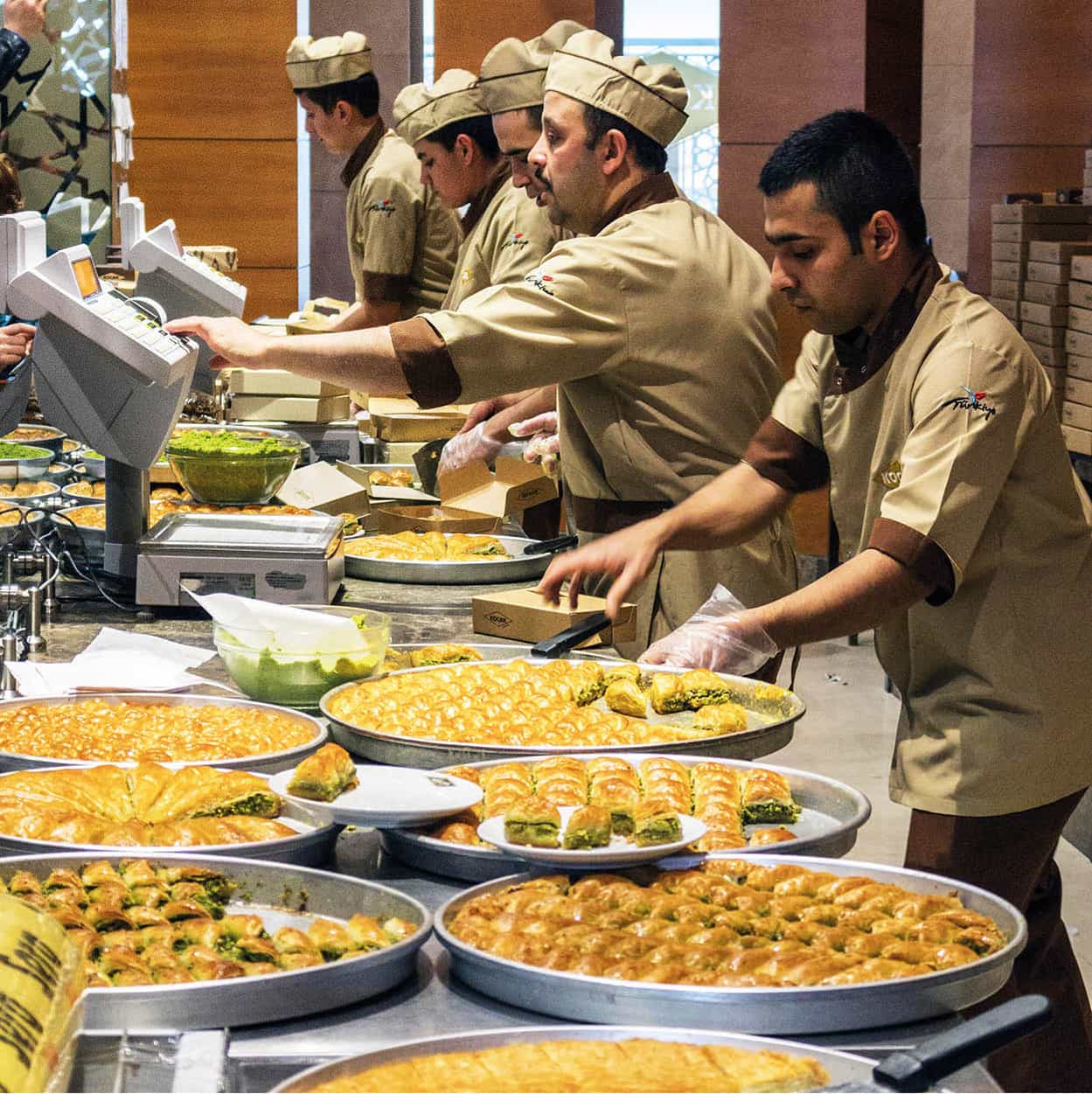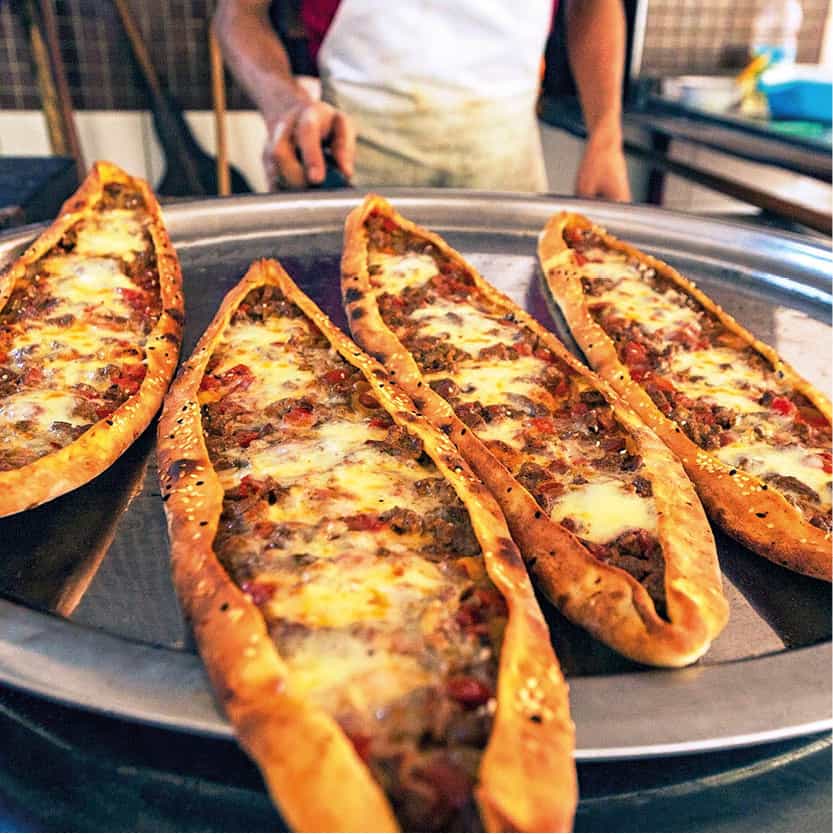The pleasures of Turkish cuisine are considerable, and travellers will find it fresh, delicious and varied. Fish caught that day, fresh vegetables and herbs, simply grilled chicken and lamb, and creamy starter-dips are the mainstays of Turkish menus. In fact, a good meal awaits you most anywhere in the country, with the spiciest (some say the best) cooking in the far southeast.

Döner: the classic Turkish snack
Frank Noon/Apa Publications
While street food and snacks are available throughout the day in most cities and resorts, you will find a full lunch from noon to 3pm and dinner from 7 to 10pm. Except in the more formal restaurants in large cities, dress is casual.
Even in İstanbul and other large towns, there are fewer full-on restaurants than there are in comparable European cities. Better restaurants, accordingly, tend to be crowded, so you may want to reserve a table in advance; your hotel may do this and arrange for transport as well. Except perhaps in peak season, you shouldn’t have a problem finding a seat. During the summer, many resort restaurants stay open well into the wee hours. Many close completely between October and May.

İmam Çağdaş, a famous spot for baklava in Gaziantep
Alamy
Where to Eat
Especially in İstanbul and other large cities, a wide variety of establishments sell the Turkish version of ‘fast food’, often at stand-up counters. A kebapcı serves the ubiquitous staple of Turkish cuisine, the kebab; lamb is continually being roasted on a revolving spit, ready to be sliced and skewered together with roast vegetables. Dönercis offer roast döner, an initially conical mass of fatty lamb or chicken which, as the day goes on, is whittled down into thin slices served atop bread or rice. A pideci offers pide, the boat-shaped Turkish pizza, a delicious concoction topped with meats, vegetables, eggs or cheese.
When Turks eat a full meal out, it is usually at a lokanta, a simple restaurant that caters to workers at lunch and, often, to neighbourhood families in the evening. The six to eight steam-tray dishes offered at any one time are displayed in a glass case, served on request; most of these establishments offer one or two meat or fish dishes, often prepared as stews, with vegetable and rice or potato accompaniments.
A full-blown restoran, or restaurant, is often only marginally fancier than a lokanta, but can also be quite elegant. In resorts, restaurant tables spill out onto terraces. Visitors will also find a number of Europeanstyle cafés serving lighter snack meals throughout the day.
What to Eat
Turkish breakfast, available in even the most modest pansiyons, is simple and satisfying. It typically includes sliced cucumber, olives, tomato, a hard-boiled egg, yogurt, seasonal fruit and bread slices to be topped with jam or honey. Only tea or instant coffee is likely to be offered. In multistar hotels, buffet breakfast can be elaborate, with omelettes live-cooked and various charcuterie laid out. Out in town, you can patronise a counter or cart from which börek, a fluffy cheese pastry, is served. Later on, the most ubiquitous snack in rural areas is gözleme, a crepe-like delicacy stuffed with a variety of fillings.
A full meal at lunch or dinner inevitably begins with meze, a wide assortment of delicious hot or cold appetisers. Several meze platters can in fact be so satisfying that you may not feel the need for a main course.
Main courses rely on various forms of lamb or chicken; pork is not served in this Muslim country, and when beef makes an appearance it is usually ground. Just about any restaurant, no matter how simple or elaborate, will serve several variations of lamb or chicken kebabs, as well as such staples as mantı, a meat-filled ravioli, and köfte, meatballs. Fresh fish, often various kinds of bream, is the mainstay of menus along the Aegean and Mediterranean coasts, where restaurants usually display the catch on ice and serve it simply grilled with oil and lemon. In the countryside you are likely to encounter restaurants that raise trout in a pond or stream and serve it at outdoor, tree-shaded tables.

Pide, a boat-shaped pizza bread, topped with meats, vegetables and cheese
iStock
Typical vegetable accompaniments are simply prepared beans, okra or cauliflower, and salad made of tomatoes, onions, peppers, cucumbers, olives and perhaps some white cheese – greens like rocket or lettuce are relatively rare. Popular desserts include baklava, phyllo pastry with honey and nuts; helva, combinations of flour, butter, sugar and flavourings; or various milk-based puddings.

Turkish wine
Frank Noon/Apa Publications
Beverages
In this predominantly Muslim country, many restaurants and cafés do not serve alcohol. It’s easier to find establishments serving alcoholic beverages – often just beer and wine – in resorts than it is in some of the inland towns less visited by non-Turks.
Turkish wines, mostly made in Cappadocia or along the Aegean coast, are widespread, and many restaurants serve nothing but domestic varieties; the two largest vintners, Doluca and Kavaklıdere, dominate the market, but it’s worth asking for local microwinery products. The most popular domestic beers, bottled or draught, are Efes Pilsen, Carlsberg and Tuborg, all at about 5 percent; Efes also makes ‘Dark’ (6.1 percent alcohol) and ‘Xtra’ (7.5 percent). By contrast, domestically made spirits like gin and vodka are worth avoiding in favour of imported labels. The alcoholic beverage of local choice, however, is rakı, similar to Greek ouzo and enjoyed before, during and after a meal, mixed with water and ice. The best brands are Efe and Burgaz, though you’re likely to be offered only the mediocre Yeni.
Poor-quality instant coffee, irrespective of brand, is almost always referred to as Nescafé; if you want something more satisfying, request Turkish coffee, usually served orta şekerli (medium sweet) or çok şekerli (very sweet). In major resorts, at least one café will be doing proper, European-style espressos and cappuccinos – at European prices. Tea, çay, is far more common, and even shopkeepers dispense it freely to their customers; it is served in small glasses, to which you can add water and sugar, but never milk, as desired.